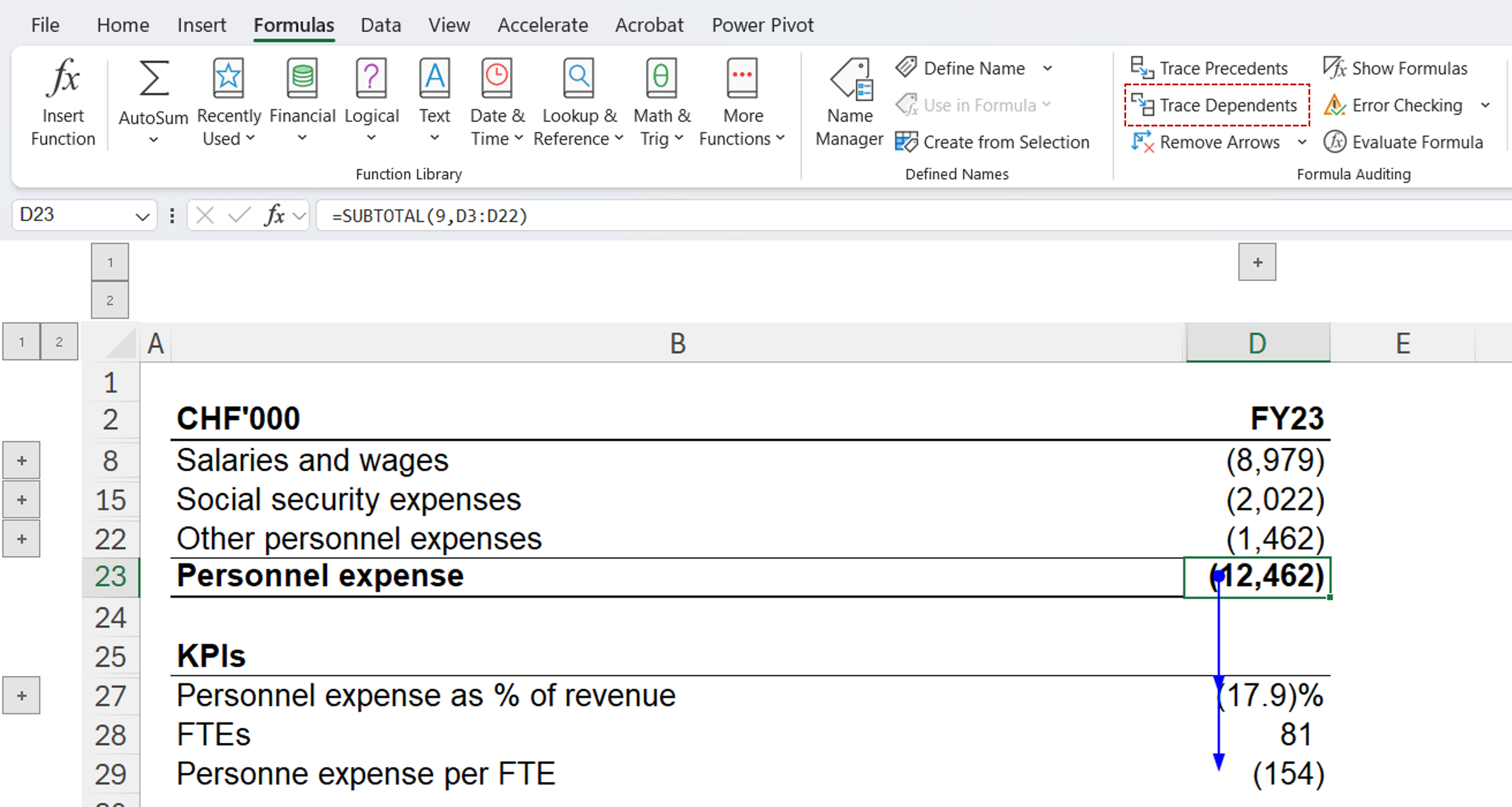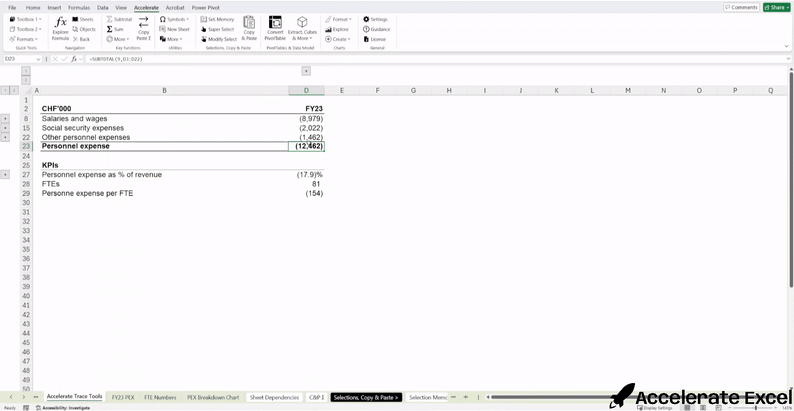Trace Precedents & Trace Dependents in Excel
In Microsoft Excel, tracing cell relationships is crucial for understanding how data flows through complex financial models. Whether you're troubleshooting errors or analyzing complex formulas, knowing which cells feed into or depend on your active cell is key. This is where Excel’s built-in auditing tools, Trace Precedents and Trace Dependents, come in handy. However, Excel's native capabilities have limitations, especially when you're working with intricate financial models. In this blog, we'll walk through how these tools work, discuss their limitations, and explore how Accelerate Excel can drastically improve your workflow.
Work Faster with Accelerate Excel
Simplify your Excel work with the Accelerate ribbon comprising tools for M&A Transaction/Deal Advisory, FDD and other Excel power users.
What Are Trace Precedents & Trace Dependents?
Trace Precedents allows you to see which cells are referenced in a formula, while Trace Dependents highlights the cells that depend on the selected cell's value. These tools help visualize the data flow, providing a clearer understanding of how your spreadsheet operates.
-
For example, if cellA5 contains the formula=B1 + C1 , both cellsB1 andC1 are precedents ofA5 .
-
Similarly, if other cells referenceA5 , they are considered dependent onA5 .
How to Use Trace Precedents in Excel?
Excel Native - Trace Precedents Tool
Tracing precedents in Excel:
Select the cell you want to analyze.
Navigate to the Formulas tab and find the Formula Auditing group (or use the shortcut Alt + M + P).
Click Trace Precedents (or use the shortcut Ctrl + [ ). Arrows will appear, pointing to the cells that feed into the selected cell, along with any dependent cells.
To trace further, keep clicking the button to reveal deeper dependencies.
To clear the arrows, click Remove Arrows.
How to Use Trace Dependents in Excel?
Excel Native - Trace DependentsTool
Tracing dependents in Excel:
Select the cell you want to analyze.
Navigate to the Formulas tab and find the “Formula Auditing” group (or use the shortcut Alt + M + D).
Click Trace Dependents (or use the shortcut Ctrl + ] ). Arrows will show the cells that rely on the selected cell's value and any precedent cells.
To trace further, keep clicking the button to reveal deeper dependencies.
To clear the arrows, click Remove Arrows.
Limitations of Native Excel Tools
Although the Trace Precedents and Trace Dependents features are useful, they have key limitations:
One Cell at a Time: Excel only allows tracing for one cell at a time, which can be tedious when you're analyzing multiple cells or complex models.
Visual Clutter: In complex worksheets, the blue arrows can overlap, making it difficult to see clear relationships.
Unsupported Elements: Excel’s tracing tools don’t track dependencies in charts or hyperlinks, leaving gaps in your analysis.
Why Use Accelerate Excel?
Accelerate Excel takes the pain out of manual cell tracing by offering more advanced and efficient solutions than Excel’s native tools. Not only does it automate the process of tracing cell precedents and dependents across multiple cells, but it also provides a cleaner, more streamlined way to audit complex models and formulas. Here’s how it enhances your workflow:
Range Tracing: Unlike Excel’s built-in tools, Accelerate Excel allows you to trace cell dependencies for multiple cells (or range) at once, significantly reducing the time spent auditing large Excel worksheets.
Deeper Insights: The tool offers detailed insights into both direct and indirect cell relationships, including dependencies in charts and hyperlinks, making it easy to trace formulas and understand how changes in a particular cell ripple through the rest of the Excel file.
Cleaner Visualization: Avoid the clutter of overlapping dependent arrows with a more intuitive interface, making it simpler to follow data flows without visual distractions.
Here’s what makes Accelerate Excel stand out with its four key tools:
List Ranges Referenced in Selected Range (Precedents): This tool allows you to find and navigate cell precedents within the selected range, opening a navigation window that lists all cell references. With arrow key navigation or a simple click, you can jump directly to any referenced range, even if it’s in another workbook or worksheet.
List Ranges Referencing Selected Range (Dependents): Easily find and navigate ranges that depend on the selected range. The tool displays a list of dependent cells, enabling quick navigation across sheets or workbooks.
Trace Sheet Precedents: This tool helps you trace precedents at the sheet level, scanning ranges, charts, and hyperlinks to show which sheets are referenced in the current sheet.
Trace Sheet Dependents: Similarly, this tool identifies which sheets reference the current sheet, listing all dependencies, including charts and hyperlinks, for easier auditing.
With Accelerate Excel, you get a more powerful way to track cell dependencies and relationships across complex models, making the process smoother and more efficient for every Excel worksheet you work on.
Conclusion
Tracing precedents and dependents is a vital part of any financial modeller's toolkit, but Excel’s native features can sometimes fall short, especially in large or intricate workbooks. With Accelerate Excel, you can discover a powerful solution that automates this process, offers deeper insights, and makes your audits faster and more accurate. If you're tired of tracing formulas cell by cell, give Accelerate Excel a try and take control of your spreadsheet audits.



